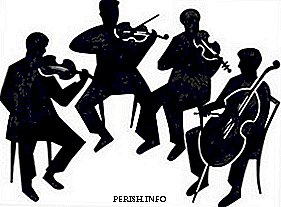 There is no greater happiness for a musician than playing music together, and the degree of professionalism of any musician is directly proportional to his skill in playing in an ensemble. Yes, he can be a wonderful soloist, who is a pleasure to listen to, but one can finally appreciate him as a musician only by listening to how he plays in a team.
There is no greater happiness for a musician than playing music together, and the degree of professionalism of any musician is directly proportional to his skill in playing in an ensemble. Yes, he can be a wonderful soloist, who is a pleasure to listen to, but one can finally appreciate him as a musician only by listening to how he plays in a team.
Ensemble - a word familiar to one and all. It is often used in relation to things that have nothing to do with music. For example, an architectural ensemble. Translated from French, "ensemble" means: coherence and consistency. That is what is its most important component. Do something together and do it in sync. In synchrony and lies the main secret and the continued success of the ensemble.
Ensembles are different, and depending on the number of musicians have their own names. Words like duet, trio, quartet known even to people far from music.
What conditions must be observed when playing in an ensemble? How to achieve coherence and thereby develop skills, without which a musician cannot be called a musician? There are several subtleties and nuances that need to be monitored until they become habit.
- Slender game, above all! A fake performance will nullify all the good beginnings, and will lead to the displeasure of the audience. We need to work on the system and work hard.
- All members of the ensemble must unswervingly adhere to the same musical genre or manner of playing. A different understanding of a musical work from a musical point of view is unacceptable. For example, a waltz should sound like a waltz, and if, suddenly, someone loses the character of a waltz and plays something close to the march, the ensemble will simply “fall apart”.
- The same understanding of tempo and rhythm. All musicians are people, not metronomes, and someone tends to slow down and accelerate to some. This must be carefully monitored, as well as the rhythm, because a distorted understanding of the rhythm will also lead to a lack of coherence and synchrony.
- Playing in an ensemble means the same performance touches. At first glance, it seems that this is not so significant, in fact, different touches are the disharmony of music, which can be avoided if you carefully consider the analysis of a musical work.
- Do not leave the "tails"! It is necessary to finish, as well as start a musical phrase at the same time, unless, of course, something else is originally intended. Very ugly and carelessly obey the end, not completed together by all members of the ensemble.
- Dynamic consistency. Solo performance should be forgotten while playing in the ensemble. If a musician leads the main theme, he should play brighter, but during counterpoint or accompaniment, the sound should be reduced.
It seems that all of the above techniques are not so difficult. In fact, playing in an ensemble requires years of concentrated work and labor, but labor that brings pleasure. Here it is necessary to catch the glances and movements of each other with greed, afraid to miss anything. It is here that sensitivity and attentiveness, qualities that are very useful in life, are important. Therefore, there is no doubt that the ensemble is a useful and pleasant thing not only for the listeners, but also for the performers!
And now let's listen to music! The music will be ensemble.

Leave Your Comment